Explore the Blue Line Metro in Dubai: Stations & Map
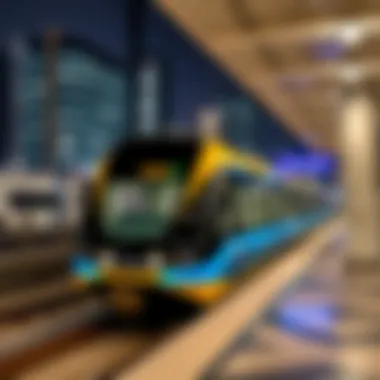
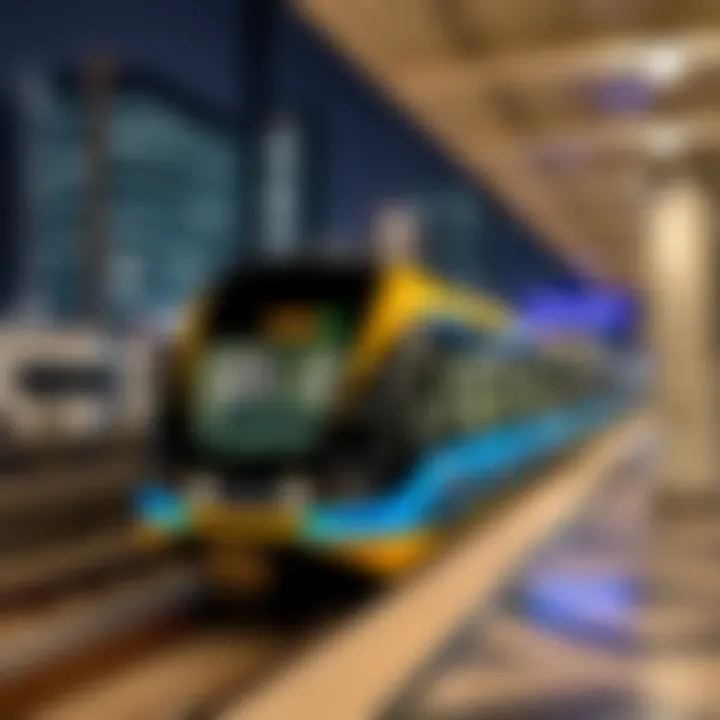
Intro
Dubai's urban landscape is an ever-evolving ecosystem, where connectivity plays a crucial role in the city's development. The Blue Line Metro, a key component of Dubai's public transit system, stands at the forefront of this evolution. It weaves through the fabric of the city, linking neighborhoods, businesses, and amenities with unprecedented efficiency. This guide aims to unravel the layers of this substantial transit line, providing an in-depth look at its routes, stations, and the spinoff benefits for the city's real estate market.
As urban areas continue to expand, the significance of reliable transport cannot be overstated. For residents and investors alike, the Blue Line represents more than just a means of getting from point A to B; it's a lifeline that enhances accessibility and increases property value, thus influencing the decision-making processes for homebuyers and investors. In the following sections, we will delve into market insights surrounding the Blue Line, practical tips for engaging with the real estate market in its vicinity, and an array of information that will assist potential purchasers, renters, and developers in navigating this vibrant part of Dubai.
Prelims to Dubai’s Metro System
Dubai's public transport system has gained considerable traction over the years, reshaping how both residents and visitors navigate this bustling metropolis. The introduction of the Metro system stands out as a paragon among its modes of transit, embodying efficiency and innovation. This section aims to provide key insights into the metro system, focusing particularly on its operational framework and the significant contributions of the Blue Line, which plays a vital role in this network.
Overview of Public Transport in Dubai
In Dubai, public transport is not just a means to travel; it's an essential element of urban life. With an impressively organized structure that includes buses, trams, and water taxis – all seamlessly integrated – the emirate has transcended the conventional notion of urban commuting.
- Metro: The standout mode, characterized by modern trains and frequent service times, offers a swift alternative for daily commuters.
- Buses: Covering the city's outskirts and providing substantial connectivity to the Metro system, they act as virtual lifelines for those living further away.
- Water Transport: Ferries and abras add a unique flavor to the transit options, enabling journeys across Dubai Creek with a picturesque view.
This robust network exemplifies how public transport can foster sustainability and reduce congestion, offering a reliable alternative to the ever-growing number of personal vehicles. The Blue Line, specifically, anchors this system, bridging critical areas and enhancing overall connectivity.
Significance of the Blue Line Metro
The Blue Line of the Metro stands as a crucial artery in Dubai's transport system. Motivation behind its construction primarily revolves around addressing the city's explosive growth and housing developments concentrated along its route. With around 23 kilometers of track and numerous strategically placed stations, it extends links to major districts including the Jumeirah Lakes Towers, Al Qusais, and the upcoming Dubai Creek Harbour.
Its significance can be summarized in the following points:
- Enhanced Accessibility: The Blue Line connects important commercial and residential areas, facilitating ease of access.
- Economic Catalyst: By fostering better connectivity, it effectively enhances property values in adjacent areas, driving demand from both homeowners and investors.
- Encouraging Sustainable Travel: With millions using the Metro annually, it promotes public transport usage and helps in minimizing the carbon footprint, aligning with Dubai's environmental goals.
"Transport infrastructure isn’t simply a necessity, it’s a game changer for urban spaces, reshaping lifestyles and economic landscapes."
Detailed Map of the Blue Line Metro
The map of the Blue Line Metro is more than just a visual representation; it's a vital tool for anyone navigating the public transportation landscape in Dubai. Understanding the layout can significantly enhance the commuting experience, highlighting both efficiency and convenience. Notably, the Blue Line is designed to facilitate access to some of the city's most important areas, making it indispensable for daily commuters as well as real estate prospectors seeking investment opportunities. Through this section, we will delve into the intricacies of the Blue Line’s map and the essential features that make it not just informative but also instrumental in urban mobility.
Visual Representation of the Blue Line
Visually, the map of the Blue Line Metro is structured for clarity and ease of use. It elegantly showcases the route, making it straightforward for passengers to identify their boarding and alighting points. Key elements include:
- Clear Color-Coding: The Blue Line is distinctly highlighted in, you guessed it, blue, contrasting against other lines, allowing for quick visual recognition.
- Station Markers: Each station is clearly marked with symbols that denote various facilities. For instance, certain icons indicate accessibility features, while others may signal nearby amenities such as parking or shopping areas.
- Interchange Stations: Important transfer junctions are highlighted, allowing commuters to understand where they can switch lines without skipping a beat.
Furthermore, the map is often supplemented with real-time updates accessible through mobile apps or digital displays at the stations, helping passengers stay well-informed about potential delays or changes.
Key Landmarks Along the Line
The Blue Line isn’t just a route; it’s a conduit to some of Dubai’s most iconic landmarks and emerging neighborhoods. The following attractions are a stone's throw away from various stations:
- Dubai Marina: Known for its waterfront views and lively atmosphere, the Dubai Marina station serves both residents and tourists looking to explore this bustling area.
- Mall of the Emirates: Famous for indoor skiing, this shopping giant is easily accessible via the Metro, linking shoppers to an amazing range of experiences.
- Jumeirah Lakes Towers: This area represents a hub of business and lifestyle destinations, easily reachable with a quick ride on the Blue Line.
- Dubai International Convention and Exhibition Centre: For professionals and visitors attending events, access to this venue transforms commuting into a breeze.
The close proximity of such landmarks reinforces the importance of the Blue Line. As the city develops, these areas along the line are expected to thrive, making the map not just a static guide but a dynamic representation of future growth and opportunity.
"A well-structured map is the foundation of an effective transit system, guiding the way for thousands each day."
In summary, the Blue Line’s map serves multiple roles, from logistical to commercial, helping cement the metro’s role in modern urban life in Dubai.
Stations on the Blue Line
The stations on the Blue Line serve as key nodes in Dubai’s transit network, connecting various neighborhoods, commercial districts, and leisure hotspots. Understanding these stations is crucial for investors, homeowners, real estate agents, tenants, and developers, as they illustrate not only the accessibility of different areas but also hint at potential growth in property values. With each station designed to cater to different needs, passengers benefit from enhanced mobility across the city.
Comprehensive List of Stations
The Blue Line features multiple stations that are strategically located to offer easy access to surrounding areas. Here’s a comprehensive look at the highlights:
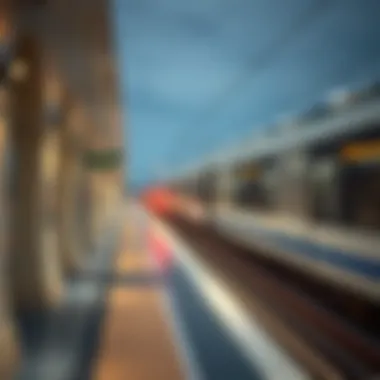
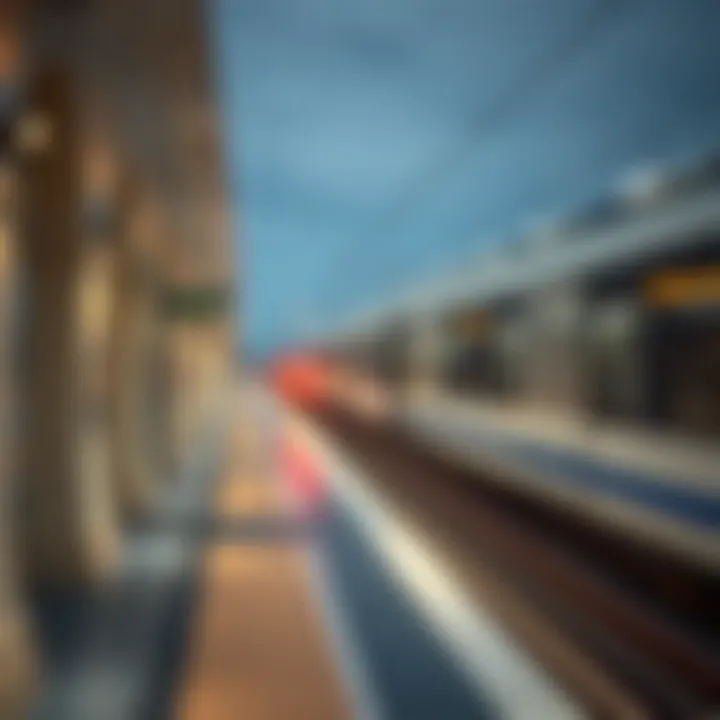
- Al Qusais: A busy hub that provides access to both residential and commercial areas, ideal for commuters
- Al Nahda: Close to parks and recreational spaces, making it popular among families
- Al Rigga: Located in the heart of the city’s vibrant hospitality sector, attracting tourists and business travelers alike
- Deira City Centre: A key station for shopping enthusiasts, offering direct access to one of the city’s largest malls
- BurJuman: This station is an interchange point that connects to the Red Line, further enhancing accessibility for passengers
- Dubai Health Care City: Vital for those working in the healthcare sector but also for visitors seeking medical services
- Dubai Marina: A hotspot for leisure, luxury shopping, and dining experiences, crucial for residents and tourists
- Jumeirah Lake Towers: Surrounded by high-rise developments, it significantly boosts property values in the area
- Expo 2020: This station marks a unique attraction since it connects visitors to the site of one of the most significant global expositions
In total, the Blue Line features nintey-eight stations, providing extensive coverage throughout critical parts of the city. Each station's unique offerings cater to the diverse needs of its users, making it an essential aspect of urban living in Dubai.
Accessibility Features at Each Station
Accessibility is a primary focus for the Blue Line’s stations, keeping in mind the needs of all passengers, including those with disabilities. Some of the key features include:
- Elevators and Escalators: Available for smooth access between different levels of stations
- Wide Doorways: To facilitate entry for people with mobility aids or strollers
- Tactile Guidance Systems: Helping visually impaired individuals navigate the station
- Audio Announcements: Essential information broadcast to assist in ensuring that everyone is kept informed about train arrivals and departures
- Accessible Restrooms: Located within stations to ensure convenience for all passengers
By incorporating these features, Dubai’s Blue Line Metro is not just a transportation system; it’s a commitment to inclusivity and mobility for every resident and visitor.
"Accessibility features highlight the Blue Line's dedication to being more than just a mode of transport; it aims to foster a community where everyone can travel without barriers."
With knowledge of the stations and their accessibility features, investors and residents can recognize the value of living near these transit points, particularly as they consider the growth of residential developments and the potential for increased property values.
Connectivity and Transit Options
The connectivity offered by the Blue Line Metro is crucial for both residents and investors in Dubai. This line does not merely run to and fro; it acts as the backbone connecting various essential services and neighborhoods. A seamless transit experience can elevate property values and make areas far more desirable.
Integration with Other Metro Lines
The Blue Line integrates flawlessly with the existing metro system, creating a web of interconnected lines across the city. This integration allows riders to change lines at key junctions, facilitating travel across Dubai with minimal hassle. Key interchange stations include Union and BurJuman, which connect to the Red Line, enhancing journey flexibility.
Having these transfers options means commuters can hop on the Blue Line for their daily grind and easily switch to other lines for further travel. Thus, investors should keep an eye on properties near these interchanges, as their accessibility often translates to increased demand and higher rental values.
"A well-connected metro system can boost local economies by providing quicker access to jobs and amenities, making neighborhoods more appealing for both living and investment."
Connecting Buses and Other Public Transport
The Blue Line doesn’t stand alone. It interfaces seamlessly with an array of bus routes and other forms of transport, effectively bridging the gaps in the city's transport landscape. Numerous bus stops are strategically placed near metro stations, providing commuters with a reliable way to reach their final destinations.
Here’s what makes this connectivity vital:
- Enhanced Reach: Accessing areas beyond the metro's coverage becomes manageable. Many buses operate within a few minutes of exiting the metro, ensuring a hassle-free transfer.
- Coordinated Schedules: Buses often coordinate with metro arrivals to minimize waiting times. Check for real-time schedules that can be found on transport apps or the Roads and Transport Authority's website.
- Diverse Options: Options vary from the traditional bus to taxis, ride-sharing services, and, for those venturing further afield, water taxis along Dubai Creek.
For those interested in property investment, locations that are easily reachable from the Blue Line and its associated transport links will certainly see an uptick in attractiveness as more people seek ease in daily commuting.
Impact on Real Estate in Dubai
The Blue Line Metro has steered into the heart of Dubai's real estate landscape, ushering in changes that resonate throughout the market. As city planners envisioned a more connected experience, the introduction of this Metro line stands as a testament to urban foresight. Not only does it alleviate some traffic woes, but it also reshapes property dynamics, affecting everything from residential lease rates to commercial property appetite.
One cannot overlook how proximity to Metro stations boosts a property's desirability. This is noteworthy for investors, homeowners, and renters alike. Recent studies have shown that properties situated within walking distance to a station command higher prices compared to those tucked away from the rail network. This burgeoning trend is a straightforward equation: accessibility leads to increased demand, which, in turn, propels property values up.
Correlation Between Metro Access and Property Values
Metro access functions as a magnet for potential buyers. Essentially, it enriches the livability of an area. People consider various factors in their home-buying decisions, access to quality transport being a pivotal one. As the Blue Line stretches its arms across the city, localities along its trail have witnessed property values dip and soar, often correlating directly with the convenience of transport options.
- Research Insights: A study by the Dubai Land Department indicated that properties near Blue Line stations appreciated by about 15-20% over a span of five years. This isn't mere happenstance; rather, it reflects a trend acknowledging that easy commutes boost urban appeal.
- Lifestyle Preferences: Merging urban living with the perks of public transit, potential buyers are increasingly looking towards properties that allow not just comfort but also ease of travel. In many cases, well-connected locales can counterbalance scenarios where buyers may have to compromise on space or luxury.
Thus, the proximity to efficient transport like the Blue Line becomes an essential factor for property valuation.
Areas of Rapid Development Along the Blue Line
Specific regions acquiring new development momentum follow the Blue Line like a shadow. These areas are becoming hotspots for both residential and commercial projects. It’s not just about immediate connections; it's about the cascading effects that stem from improved transportation.
- Deira Metro Station: This legacy neighborhood has undergone a renaissance. Once overlooked, the development of the Blue Line paved the way for new apartment complexes, boutique hotels, and retail outlets to come alive.
- Meydan: An area known for its luxurious lifestyle, with the Blue Line’s arrival, developers are snapping up plots to introduce new high-rise luxury apartments. Here, one would find improved access to the city, enriching the real estate portfolio.
- Dubai Creek Harbour: This new urban center is bustling with activity. The promised Blue Line connection is set to unlock further potential for both commercial spaces and residential units, making it a prime target for real estate investment.
The overall landscape is changing rapidly, with the Blue Line steering developers and investors to areas once considered out of reach.
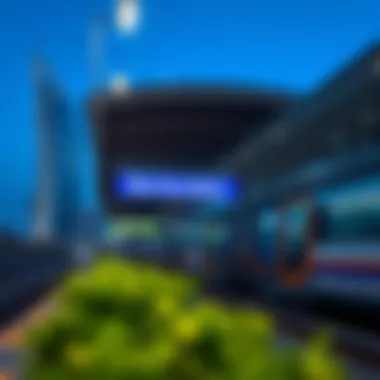
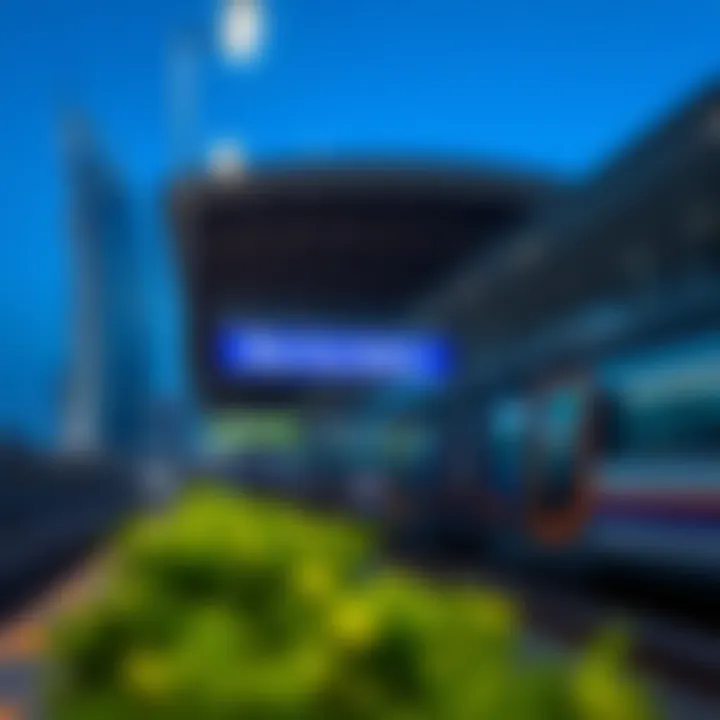
Proximity to the metro translates not just to convenience but also to economic advantage, influencing both rental yield and capital growth.
Lifestyle Benefits of the Blue Line Metro
The Blue Line Metro isn’t just a mode of transport; it’s a lifeline for many in Dubai. As the city evolves at a rapid pace, the integration of this metro line into the daily lives of residents and visitors cannot be overstated. It enhances not only mobility but also the lifestyle of many who rely on it every day. This section explores how the Blue Line contributes fundamentally to the convenience, accessibility, and enjoyment of daily life in Dubai.
Convenience for Daily Commuters
For daily commuters, convenience may just be the pinnacle of their transportation needs. The Blue Line Metro offers several features that streamline commuting and cater to the busy lives of residents:
- Time-Efficiency: The Blue Line connects to major hubs and residential areas, significantly reducing travel time. Trains run frequently, ensuring you won’t be waiting long at the station, even during rush hours.
- Reliable Service: With most commutes being punctual, commuters can trust the schedules to plan their days better. That reliability is something not often found in other modes of transport.
- Cost-Effective: Taking the metro proves to be economically favorable compared to ride-sharing services or taxis, which can add up, especially during peak hours. For those summoning the ambiance of Dubai’s lifestyle without breaking the bank, the metro stands as a wise choice.
- Stress Reduction: With the ease of connections to various districts, the hassle of navigating through traffic is eliminated. The quiet of the metro allows for moments of peace before or after a busy workday.
As noted by local commuters, "It’s easier to breathe while moving around the city." These experiences encapsulate the essence of commuting with the Blue Line.
Access to Cultural and Entertainment Venues
The Blue Line Metro also offers unparalleled access to cultural and entertainment venues that define Dubai. Whether you're an art lover, a foodie, or a thrill-seeker, the metro opens doors to possibilities:
- Cultural Hotspots: Key stations are situated close to museums and galleries. For example, a few stops away from the Dubai Aquarium and Underwater Zoo, you can immerse in exhibitions that showcase art and history. The proximity encourages residents to explore more without stress.
- Entertainment Districts: The metro takes commuters right to the heart of entertainment areas like Dubai Mall and Downtown Dubai. With shows, dining, and retail therapy all nearby, weekends can effortlessly transform into day-long adventures.
- Accessibility to Events: Frequent visitors can enjoy attending concerts, exhibitions, or festivals without worrying about parking or long commutes home.
"Having the metro nearby means we can pop out for a concert or art show on a whim," says a resident. This sense of spontaneity broadens community engagement and involvement.
Additionally, the Blue Line presents informative signage at each station, helping even newcomers navigate their way around, bridging cultures with ease.
In essence, the lifestyle benefits provided by the Blue Line Metro are multidimensional. They touch every aspect of daily life from practical conveniences for commuters, to avenues of cultural exploration. As investors observe these lifestyle trends, the Blue Line undoubtedly adds value to various neighborhoods, ushering in a bright future for urban living in Dubai.
Future Expansion and Developments
Future Expansion and Developments of the Blue Line Metro represents a critical facet of urban planning and transportation in Dubai. With the city rapidly growing and evolving, the need for efficient and modern transit options becomes paramount. The planned extensions of the Blue Line are not just about adding more stations; they symbolize a strategic move to enhance connectivity across various districts, making it easier for residents and visitors to navigate the city.
Planned Extensions of the Blue Line
The ambitious plans for extending the Blue Line are designed to support the increasing population and urban sprawl. Among the proposed expansions, the most notable is the extension towards Dubai Marina and beyond. This area is known for its dense population of expatriates and tourists alike.
By further extending the Blue Line, the government aims to:
- Improve access: Residents in upcoming developments such as Bluewaters Island and Jumeirah Beach Residence would gain easier access to the Metro, promoting the use of public transport over private vehicles.
- Stimulate economic growth: The increased connectivity will attract more businesses to set up shop in the vicinity, allowing commerce to thrive.
- Promote sustainability: Encouraging public transport use over personal vehicles can significantly reduce carbon emissions, aligning with Dubai's environmental goals.
This extension isn’t just a pipe dream; various studies have indicated that it might be completed by 2025. Such efforts could create a ripple effect, enhancing overall mobility in the region.
Impact of Future Developments on Real Estate
Future expansions of the Blue Line will invariably have a significant effect on real estate dynamics in Dubai. As new stations are developed, property values in surrounding areas will likely increase owing to improved accessibility. The market often reacts favorably to any signals of enhanced connectivity.
Here are some factors to consider regarding the impact on real estate:
- Increased demand: Properties located near new metro stations often see a surge in demand. Prospective buyers, particularly investors, look for easy access to public transport as a vital feature.
- Rising property values: As easy access to the Blue Line becomes a reality, property prices may rise sharply in the areas adjacent to the new stations. This will likely make investments in these neighborhoods more appealing to investors and homeowners alike.
- Urbanist initiatives: The local government may put in place favorable zoning laws to encourage developments around the new metro stations, creating vibrant mixed-use spaces that can accommodate businesses, leisure, and homes.
In summary, the future expansion of the Blue Line is not simply a logistical enhancement; it's a factor of considerable influence in the real estate market of Dubai. As connectivity and urban accessibility improve, investors, homeowners, and tenants will find new opportunities and challenges in a landscape that is ever-evolving, ultimately helping Dubai become a more interconnected metropolis.
Key Insight: The Blue Line's role in shaping future development cannot be underestimated; it’s a game-changer for both transport and real estate in Dubai.
Navigating the Blue Line: Tips for First-Time Users
Navigating the Blue Line of Dubai's Metro can be a breeze for first-timers when armed with the right knowledge. Understanding the various facets of this transit option not only eases the travel experience but also enhances the overall benefits that come with riding this pivotal line in the city’s transportation infrastructure. For those keen on real estate investment, familiarizing oneself with the Blue Line's connections can help in making informed property choices.
Purchasing Tickets and Payment Options
Before boarding, it's essential to get the ticketing process down pat. The Blue Line Metro has simplified the purchasing process significantly, making it user-friendly for locals and tourists alike. Tickets can be purchased from automated machines available at all stations. These machines accept cash and card payments, streamlining the entire transaction.
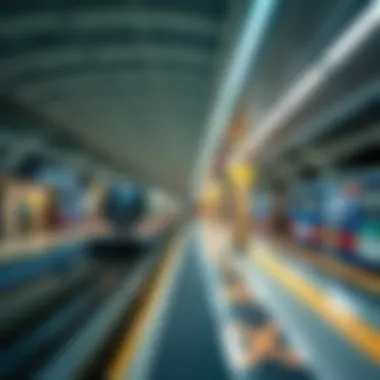
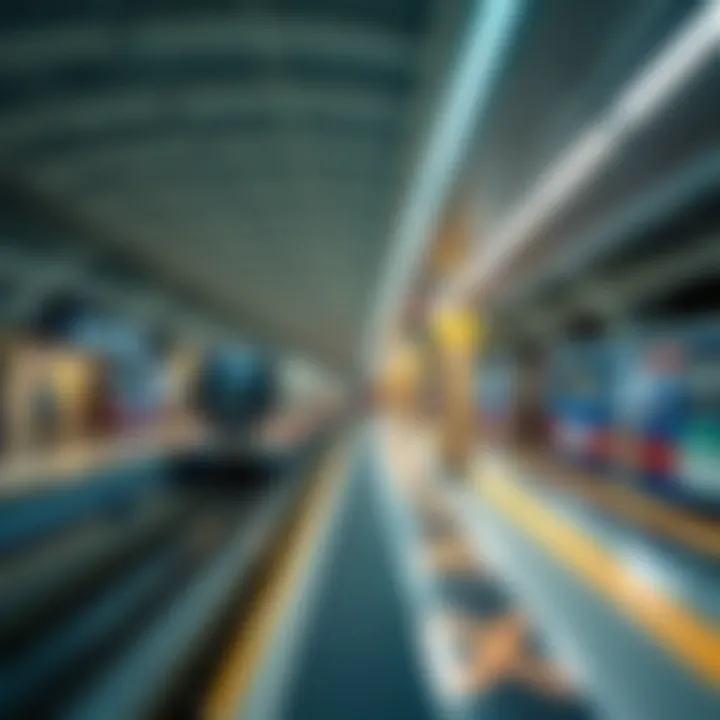
Different ticket types cater to varying travel needs. For instance, a standard single journey ticket can be perfect for one-off trips around the city. Meanwhile, for regular commuters, a nol card offers unmatched convenience, allowing for multiple rides while saving a few dirhams in the process.
To purchase a nol card, simply follow these steps:
- Locate a Ticket Machine: These machines are easy to spot, often placed near the station entrance.
- Choose Your Language: Select your preferred language—Arabic or English is usually available.
- Select Card Type: If it's your first time, go for the nol card, as it's reloadable and can be used across all public transport systems in Dubai.
- Add Value: Choose how much credit you want to load onto the card.
- Complete the Transaction: Follow the prompts to pay, and your card will be ready to use.
Also, for peace of mind, it's good to remember that a nol card can be topped up at various convenience stores across the city.
"Efficiency is the hallmark of modern transit; the Blue Line exemplifies how Dubai is embracing the future of urban mobility."
Understanding the Train Schedules
Getting the hang of train schedules can significantly enhance your travel experience on the Blue Line. The trains operate frequently, with intervals ranging from every 3 to 7 minutes, depending on the time of day. Early morning rush hours see the trains running more frequently to accommodate commuters who need to get to work.
Printed schedules are available in every station, usually plastered on the walls near the platforms. However, for those who prefer a digital approach, the official RTA app is invaluable. Signing up for alerts can also keep you updated about any delays or changes in service. Here’s what you need to consider:
- Check Operating Hours: The Blue Line generally operates from 5 AM until midnight on weekdays and till 1 AM on weekends. Knowing these hours can prevent any last-minute scrambles.
- Track Your Route: Each train is marked with its destination and stops, so keep an eye on the electronic display boards that show real-time updates.
- Plan Ahead: If you're heading to a specific event or location, planning your trip ahead is wise. Consider peak hours if you want to avoid crowded trains.
With these bits of information, first-time users of the Blue Line can navigate with confidence. Knowing how to purchase tickets and understanding the train schedules are foundational steps that enhance the travel experience. This familiarity not only helps the average commuter but also positions investors and residents to make better choices in their endeavors around the dynamic fabric of Dubai’s urban environment.
Safety and Security Measures on the Blue Line
Ensuring the safety and security of passengers riding the Blue Line Metro in Dubai is a paramount concern that bolsters public confidence in the transit system. With millions of commuters relying on the Metro daily, a robust safety framework is essential. This framework not only protects users from potential dangers but also enhances the overall commuting experience. The investments made in safety measures reflect the city's commitment to providing secure transportation options.
Civil Protection and Emergency Protocols
In the event of emergencies, the Blue Line Metro is designed to respond swiftly and effectively. Civil protection protocols are established to ensure public safety at stations and throughout the metro system. For instance, each station is equipped with clear signage directing passengers to emergency exits, equipped with emergency lights and exit signage as needed, ensuring that individuals can navigate their way safely in case of an emergency.
Moreover, regular drills involving station personnel are conducted to prepare for unforeseen incidents, such as natural disasters or fires. These drills focus on evacuation procedures, first aid training, and situational awareness, cultivating a ready and capable workforce at each station.
Also, the Blue Line features intercom systems for real-time communication between passengers and staff. In situations requiring urgent attention, passengers can contact station personnel in seconds. In sum, the combination of visible emergency protocols and trained personnel contributes significantly to the safety of the Blue Line.
Surveillance and Monitoring Systems
The security of the Blue Line Metro is significantly enhanced through extensive surveillance and monitoring systems in place. High-definition cameras are installed at key locations throughout the stations and within trains, providing continuous real-time monitoring. These cameras act as a deterrent to potential misconduct and allow for swift action should any suspicious activity arise.
In addition, a central security control room monitors the live feeds from cameras, ensuring that trained personnel are on alert 24/7. This vigilant oversight allows authorities to respond promptly to any incidents while deterring criminal activities.
Furthermore, all personnel stationed at the Blue Line undergo rigorous training regarding security issues and surveillance protocols. Their familiarity with the surveillance technology and incident response procedures adds another layer of reassurance for commuters.
"Safety measures in transit systems such as the Blue Line Metro reflect a broader commitment to community well-being and public trust."
End: The Blue Line's Role in Shaping Dubai’s Urban Landscape
The Blue Line Metro is not just a mere addition to Dubai's public transport system; it is a cornerstone for the urban framework of the city. This line interconnects critical zones of activity, epitomizing the evolution of urban mobility in a rapidly growing metropolis. As Dubai continues to juggle its aspirations for modernization while preserving a sense of cultural identity, the Blue Line stands out as a significant accomplishment aligning with these objectives.
It enhances accessibility, bringing unexpected benefits to various sectors. For instance, the increased footfall around stations has led businesses, from coffee shops to extravagant retailers, to crop up like mushrooms after rain. This not only generates economic vitality but creates jobs and boosts local economies.
Key considerations include:
- Integration with urban development projects: The Blue Line serves as a catalyst for ongoing and future developments, linking residential areas and commercial hubs in a manner that shapes property values.
- Sustainability: As part of the broader strategy to reduce traffic congestion and lower carbon footprints, the Blue Line supports an eco-friendlier commuting option.
- Urban lifestyle enhancement: Offering ease of movement contributes to an overall improved quality of life, allowing residents to live, work, and play without being tethered to gridlock and road woes.
In summary, the Blue Line is more than a transit route; it is a vital thread woven into the fabric of Dubai’s urban tapestry, shaping how residents navigate their day-to-day lives.
Summary of Key Points
- The Blue Line operates as a vital link within Dubai’s Metro system, serving as a major transit artery.
- It plays an integral role in boosting local economies through increased accessibility.
- The line is a driving force behind property values and urban development.
- By promoting sustainable transportation solution, it contributes to the city's environmental goals.
- It enhances the overall quality of urban life in Dubai by facilitating ease of mobility.
Reflection on Future Trends in Urban Mobility
As we peer into the future of urban mobility, a few trends start to emerge. Cities worldwide are recognizing the importance of smart transit solutions to ease overcrowding and improve quality of life. The Blue Line may likely evolve to incorporate technological advances, such as intelligent transport systems that provide real-time updates to riders.
Moreover, the emergence of electric and autonomous vehicles stands to complement the Metro, creating a seamless commuting experience. Future developments may see further integration with other modes of transport, including taxis and ride-sharing services, along with expanded routes that cover unserved areas, promoting inclusivity.
With Dubai’s ambition to be at the forefront of innovative urban living, the Blue Line could very well serve as a model for public transport systems across the globe. The ever-growing demand for efficient mobility solutions will compel the city to stay ahead of the curve, ultimately enhancing the connectedness and convenience that residents and visitors alike have come to expect.
In closing, the Blue Line not only represents an investment in infrastructure but also signals a commitment to shaping a sustainable and vibrant urban future for Dubai. Whether you are a commuter, an investor, or simply a visitor, this vital transit line is sure to shape experiences in new, dynamic ways.















